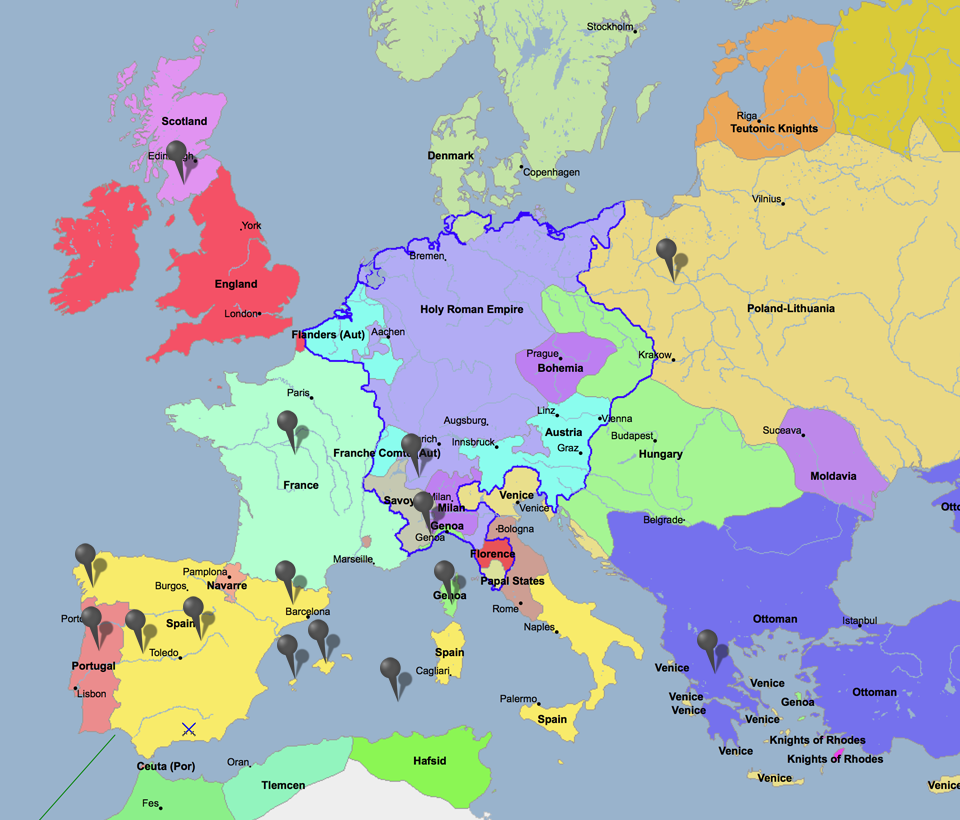Columbus on the Spanish Curriculum
Columbus' nationality in the Spanish textbooks
In spite of the fact most historians agree with the Italian origin of Columbus, there is a long list of alternative hypotheses on the discoverer's birthplace. But, what has your teacher told you in class? What does your book say about Columbus' nationality? Would you be able to find information about any of these hypotheses? With these activities you'll be able to approach to the "mystery" of Columbus' origin.

Click on the different landmarks to learn more about the different hypotheses about his origins.
Tasks:
|
1 |
Have a look at the previous map. Each of the points in it represents one of Christopher Columbus possible birthplaces. Click on each of them and you'll get a brief information. a. Which of them do you think is the most probable Columbus' birthplace? Explain your answer. b. Which of the possible birthplaces seems the strangest or the most improbable to you? Why? |
|
2 |
Search your textbook and find if Christopher Columbus' origin is indicated. Next: a. If this information doesn´t appear. What do you think is it due to? b. If some nationality is indicated, what is it? c. According to the information in the book, do you think is there any doubt on that subject or, on the contrary, is his origin established with complete certainty? |
|
3 |
Surf the internet to get information about the possible origins of Columbus. Write a short essay (10-20 lines) and present it to the rest of your classmates in the classroom. |
Tasks:
Next some tasks are suggested to be done with the students in the classroom. Green colour is used to indicate some suggestions for their development, if considered necessary. You can use the activities suggested in the "student" version, adapting them conveniently.
|
1 |
Ask your students to have a look at the previous map. Each point on it represents a possible Christopher Columbus' birthplace. Ask them to press each one of them to get a brief explanation. Next you can ask them to do the following tasks: a. Choose two or three birthplaces which appear to be more probable to you and justify your choice. Do the same with those more improbable or unbelievable to you. (personal activity. Estimated time: 5 minutes) b. Debate about your choice with your classmates in small groups (3-5 members. Estimated time: 5 minutes). Choose one or two places you consider more probable to locate his birth, given reasons in that regard. Do the same with one or two places you consider more unbelievable. c. Choose a speaker and show your conclusions to the rest of classmates (estimated time: 1 minute per group) |
|
2 |
Ask the students to search for information about Columbus' origin in their textbooks. (Estimated time: 15 minutes) a. With the result of this search , arrange a brief debate about the reasons why this information doesn't appear ( or it does, and how it does) (Suggestions for the debate: Is other conquerors' or discoverers': Pizarro, Cortés, Magellan, Vasco da Gama's nationality indicated, but that of Columbus is not? Is it an irrelevant information or has it intentionally been left out? If the nationality is indicated, is it clearly done or is it somehow doubtful?) b. Regardless of the result, ask the students what possible reasons could be used to doubt Columbus' nationality. |
|
3 |
Arrange students in groups of two or three people and, in a computer classroom, tell them to search for information about the different hypotheses about Columbus' birthplace to: a. Compare the information they find in different websites and make up a short summary of the results (estimated time: 15 minutes)
b. Show the results of each group to the rest of classmates. (estimated time: 3 minutes per group) |
Este artículo está licenciado bajo Creative Commons Attribution-ShareAlike 2.5 License